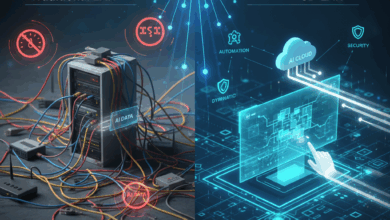SD-WAN Micro Segmentation explained to help you get the most from software defined networking.
Trying to wrap our heads around how enterprise networks function today, especially with the rise of SD-WAN and our existing LANs, can feel like untangling a bowl of spaghetti. Add in a vital security concept like micro-segmentation, and things can quickly get complex.
But trust me, understanding micro-segmentation, and how it applies to both SD-WAN and traditional LANs, is absolutely vital. It’s a cornerstone of the Zero Trust philosophy, fundamentally changing how we protect our digital assets.
The Network of Yesteryear
Let’s quickly recall how our networks traditionally operated, and how many still do, here in June 2025. Think of your typical Local Area Network (LAN) as a large, relatively open office building. Once you’re inside the main entrance – your perimeter firewall – you generally have pretty free reign.
You can move freely between different departments, access various servers, and connect to a wide range of devices. Security primarily focused on keeping the bad guys out of the building itself.
We might have used Virtual Local Area Networks (VLANs), which are like dividing the building into large floors. This offers a basic level of separation, perhaps for finance versus marketing. But within those large sections, traffic flows pretty freely, a concept known as “flat” networking.
Now, extend this to your Wide Area Network (WAN). This is how our branch offices, remote sites, and even cloud environments connected to headquarters. Traditionally, this often involved dedicated, expensive MPLS circuits.
These created a secure, private highway between our scattered buildings. While reliable and somewhat secure, they were rigid, costly, and didn’t adapt well to the increasing use of cloud applications.
The fundamental flaw in this traditional model, on both LAN and WAN, was the implicit trust granted. Once a connection was established, or a user was authenticated at the perimeter, they were largely trusted.
If an attacker breached that initial defense, they could move laterally, unimpeded, through vast swathes of the network. This allowed them to hunt for valuable data or systems to exploit. This “lateral movement” is precisely what micro-segmentation aims to stop.
What is Micro-segmentation? It’s Granular Control
Micro-segmentation is a network security technique that divides a network into distinct, isolated segments. This separation can go down to the level of individual workloads, applications, or even specific processes.
Think of it less like floors in a building, and more like giving every single office, desk, and filing cabinet its own locked door with a unique key. Each key only opens the doors it absolutely needs to.
Instead of broad network zones defined by IP addresses, micro-segmentation applies granular security policies. These policies control East-West traffic – communication moving within the network or between connected segments.
The core idea is to enforce the principle of “least privilege” at the network layer. A workload or application should only communicate with the specific resources it absolutely needs, and nothing else.
How does this work without physical firewalls everywhere? It’s predominantly software-defined. It uses policy engines and enforcement points built into hypervisors, network switches, or endpoint agents.
For instance, Illumio is a leader in this space. They install lightweight agents on servers, virtual machines, and containers.
These agents monitor traffic flows and enforce policies, acting as tiny, distributed firewalls. They build a secure “bubble” around each critical application component.
If a web application server needs to talk to a database, the policy explicitly allows only that specific communication. Everything else is blocked by default, containing potential threats.
LAN Micro-segmentation Explained
Within a traditional Local Area Network (LAN), micro-segmentation significantly boosts security beyond what VLANs can offer. VLANs separate traffic into broadcast domains, but within a VLAN, traffic can still move freely.
Micro-segmentation, in contrast, focuses on granular, workload-level isolation. Imagine a corporate LAN with VLANs for development, HR, and finance.
In a traditional setup, if a developer’s workstation is hit with ransomware, it could spread across the development VLAN. It might even pivot to other VLANs if routing isn’t incredibly tight.
With micro-segmentation, the game changes. Your development workstations are segmented, and your source code repository server is micro-segmented from everything else.
Even if a developer’s machine is compromised, Illumio’s solution would prevent that workstation from initiating connections to the source code repository or the HR database. The malware is contained to that single compromised endpoint, unable to move laterally.
IOT Micro Segmentation
Another powerful example on the LAN is in an IoT environment. Enterprises are integrating countless IoT devices, from smart lights to manufacturing robots. These often have limited security and are easy targets.
A micro-segmentation strategy can place each type of IoT device – or even individual devices – into its own segment. So, if a smart lightbulb is compromised, Versa Networks’ Universal SASE Platform can isolate that specific device.
It automatically detects the device’s profile and assigns it to a tightly controlled micro-segment. This prevents it from communicating with sensitive corporate servers or other IoT devices. An attacker stuck in a smart bulb can’t pivot to a critical production system, dramatically reducing the IoT attack surface.
SD-WAN Micro-segmentation Explained
Now, let’s see how micro-segmentation plays out in Software-Defined Wide Area Networks (SD-WAN). SD-WAN itself was a massive leap forward. It creates a virtual network over various underlying services like broadband internet or MPLS.
This allows for centralized control, intelligent traffic routing, and better application performance. It smartly directs traffic; for instance, VoIP might use the lowest latency path, while web Browse goes over cheaper links.
While SD-WAN boosts performance and cuts costs, security remains critical. This is especially true as more traffic directly “breaks out” to the internet from branch offices, known as Direct Internet Access (DIA).
This is where micro-segmentation extends its protection beyond the data center, reaching into the widely distributed enterprise.
Micro Segmentation in Retail
Consider a retail chain using SD-WAN. Each store is connected, with POS systems, inventory management, guest Wi-Fi, and employee devices. Integrated micro-segmentation lets you create granular segments for each.
For instance, POS systems could be in a highly restricted segment, only allowed to communicate with the central payment processing server. Guest Wi-Fi could be completely isolated from all corporate networks.
Many modern SD-WAN solutions, particularly those evolving into Secure Access Service Edge (SASE) platforms, now build micro-segmentation directly into their capabilities.
For example, Fortinet’s FortiGate SD-WAN appliances integrate next-generation firewall functions for deep packet inspection and application-aware policies. A policy can dictate that only POS application traffic from a specific store reaches the payment gateway.
This enforces strict application-level segmentation across the WAN. If malware infects an employee’s laptop in a branch, the micro-segmentation policy, enforced by the SD-WAN appliance, prevents it from accessing the POS system or corporate ERP.
Cloud On Ramp
Another powerful example is direct cloud access. SD-WAN lets branches connect directly to cloud apps like Microsoft 365 or Salesforce. This boosts performance but creates new security challenges.
A SASE platform, combining SD-WAN with security services like CASB and ZTNA, extends micro-segmentation to these cloud connections. Zscaler’s Zero Trust Exchange, for instance, acts as a cloud-native security platform.
When a branch user accesses a SaaS application, Zscaler verifies the user, device posture, and application before allowing access. It’s not just network segmentation; it’s segmenting access at the application layer.
This ensures that even an authenticated user might be blocked from a sensitive app due to poor device security. It applies “least privilege” directly to the cloud application stream, something traditional WANs couldn’t do.
A Zero Trust Future
It’s clear that micro-segmentation isn’t just for the data center anymore. It’s a critical component of a comprehensive Zero Trust strategy spanning both the LAN and the WAN. The power lies in their synergy.
On the LAN, micro-segmentation solutions from Palo Alto Networks’ Zero Trust Platform (with host-based segmentation) or Cisco Secure Workload (formerly Tetration) offer surgical precision. They control East-West traffic within our campuses and data centers.
These tools act as an internal tripwire. If an attacker bypasses the perimeter or compromises an internal system, their ability to move laterally and escalate privileges is severely hampered. This containment drastically cuts the potential impact of a breach.
On the WAN, SD-WAN capabilities, especially as they evolve into SASE architectures, extend these Zero Trust principles to our distributed workforce and branch offices. Vendors like Versa Networks and Fortinet are embedding micro-segmentation directly into their SD-WAN offerings.
This provides a unified approach to security across the entire enterprise. Consistent, granular security policies for micro-segmentation can be defined centrally and enforced uniformly. This applies whether the user is in the head office, a remote branch, or working from home.
The journey toward a truly robust, Zero Trust enterprise network is ongoing. It means moving away from implicit trust and embracing an architecture where every connection is verified. Every access is scrutinized, and every workload is isolated.
By deeply understanding and strategically implementing micro-segmentation across both our LANs and our SD-WANs, leveraging advanced vendor capabilities, we can build a resilient, secure network. This network will not only meet today’s demands but also be ready for tomorrow’s challenges. It’s a fundamental shift, and it’s one we absolutely must make to safeguard our digital future.



